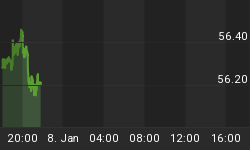Some of the readers who have read my musings over the last few years understand that I am a big fan of properly designed and implemented hedging programs for commercial producers. Whether it is in the grains, the livestock markets, cotton, crude oil, or gold - it doesn't matter as far as I am concerned. All producers should have risk management programs in place to protect them from sharp downward falls in price that might potentially impact the commodity that they are involved in producing.
I urged gold mining producers some couple of years ago to hedge some of their expected production when gold entered in a bear market. For that, I caught some of the usual grief that can be expected from the gold perma bull crowd.
The simple truth is however that no one, including those most involved in the production of a commodity can know in advance when some sort of circumstances might arise that can negatively impact the price of the commodity they produce and as a consequence, threaten the profitability of their firm, if not its very survival.
We have already seen this occur in gold mining outfits after the price of the metal collapsed from $1900 to below $1200, a level at which it is currently trading. Unhedged mining companies are now a financial shipwreck as the cost to mine the product has fallen below the breakeven point for some of the higher cost producers. NOT TO HAVE HEDGED is simply inexcusable.
The same goes for shale oil producers. One has to wonder how many might have looked at crude oil prices trading above the $80 level, viewing that as a floor and thus neglecting to secure any downside price protection ( short hedges) and lock in some excellent profits while the market was giving them the opportunity to do just that. Once that floor at $80 went, events have now seemed to spiral out of control so that the survivability of some of these shale firms is now in question.
Some of this comes as a result of pressure from shareholders who do not want to limit the upside price potential for the shares that they hold in these firms. that is understandable. However, management needs to learn how to convey the concept of price risk to its shareholders.
The old saying that "A bird in the hand is worth more than two in the bush" should be stressed to shareholders. Not all production has to be locked in and hedged but certainly any firm that has more than half of its production unhedged and thus not price-protected has crossed the line between sound management and risk management policies and that of a speculator. Management exists to ensure the profitability of their firm; not by playing the markets as if they are in a casino.
I would dare say that if some of these shale oil producers had actually implemented a sound hedging program, they would easily be able to ride out this extremely difficult period in their industry. When it is over, they would come out on the other side in tremendous financial condition and might even possibly be in position to acquire the assets of some of those outfits who went under or were needing capital to survive.
That is the reason why an article I was reading last evening about an Australian mining company was so interesting to me. Dow Jones carried the story about Evolution Mining down under and how the company had hedging an additional 225,000 ounces of gold production at a price of A$1541.
I know nothing about this company but when I read that they had hedged at total of 347,730 ounces of gold at an average price of $A$1541, I thought to myself: I wonder what might have happened to the share prices of US gold mining companies who had followed their lead back when prices first fell through the $1530-$1525 floor and officially entered a bear market? I suspect that the chart patterns would have looked a lot differently than the debacle that has existed in there for so many years now.
By the way, here is a chart of the price of gold in Australian Dollars ( Aussie Gold). It is rather fascinating to me to see the price level at which Evolution instituted the bulk of its hedges.
Look at how well they read the technical price chart and adjusted their hedging strategy accordingly. When price fell through the double bottom support zone formed in 2012 near the $1540 level, they waited to see if the price would rebound. Once it did, and failed to extend past that broken support level for any length of time, they hedged.
As a speculator, I could not have timed any short position better. Now, they have locked in prices on their gold about 16%-18% off the all time high price for gold in Australian Dollar terms. That is pretty doggone good.
Like I said, U S gold mining companies could learn something from this firm.
Please note - that I do not trade stocks nor do I have any position in this company - I merely cite it as an example of how to construct a properly designed hedge.

















